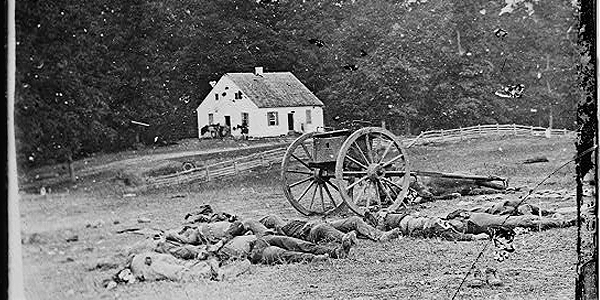
- This event has passed.
Book Talk – September Mourn: The Dunker Church of Antietam Battlefield

Hear the full story of one of the Civil War’s most iconic structures – the Dunker Church on the Antietam Battlefield

Join author Terry Barkley on December 1 at 2:30 PM at the National Museum of Civil War Medicine as he uncovers the full story of one of the Civil War’s most iconic structures – the Dunker Church on the Antietam Battlefield. Few people know much, if anything, about its fascinating back story, the role it played within the community of Sharpsburg, and its importance during and after the Battle of Antietam. Barkley corrects this oversight.
On September 17, 1862, two mighty armies grappled across the rolling hills, fields, and woodlots surrounding Sharpsburg, Maryland. The combat killed, wounded, or left missing more than 23,000 Union and Confederate soldiers, repulsed Lee’s invading Virginia army, and paved the way for Abraham Lincoln’s Emancipation Proclamation. Ironically, the small whitewashed building dedicated to peace, equality, and the brotherhood of man stood in the epicenter of that bloodiest day in American history.
The German Baptist Brethren, or Dunkers (Dunkards) as they were colloquially known, built the Mumma Church of the Manor congregation in 1853, just nine years before Antietam. In addition to being a house of worship with important ties to the local community, the history of the Dunker Church is linked with such notable figures as Stonewall Jackson, Clara Barton, Abraham Lincoln, and even Mark Twain. The structure was heavily damaged during the battle, housed torn bodies as a hospital in its aftermath, and suffered a complete collapse before undergoing the long and arduous process of being rebuilt. Barkley will uncover all the hidden history the Dunker Church has to offer.
The program begins 2:30 PM in the Delaplaine-Randall Conference Room at the National Museum of Civil War Medicine on December 1. The presentation is included with museum admission.
Terry Barkley served as archivist and museum curator at Bridgewater College in Virginia, a Brethren-related institution, and holds degrees and a graduate certificate from the University of North Alabama, The Citadel, University of Alabama, and Harvard University. He retired in 2012 as director of the Brethren Historical Library and Archives (BHLA) at the Church of the Brethren General Offices in Elgin, Illinois. He is an independent scholar and musician and lives in Lexington, Virginia. This is his fourth book.


